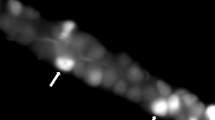Abstract
The 3.5 s efflux ofd-lactate (1 mmol/l) injected in the lumen of the late proximal convolution was measured. This efflux can be divided into a Na+-dependent, saturable component flowing through the brush border and a Na+-independent non-saturable component flowing through the paracellular pathway. The inhibitory potency of benzoate and its analogs, of phenyl-substituted acetate-, propionate-and butyrate analogs, of cinnamate and analogs, of heterocyclic monocarboxylic acids and related compounds added to the perfusate in a concentration of 10 mmol/l was measured. It was found that
-
1.
benzoate added in a concentration of 10 mmol/l to the luminal perfusate inhibits transport ofd-lactate, and the meta- and para-substituted analogs of benzoate inhibit in a fashion predicted by Hammett's theory. Side groups which withdraw electrons from the COOH group inhibit while substitutes who deliver electrons toward the reaction center do not.
-
2.
Replacement of a hydrogen atom by a phenyl ring at the C2 atom of acetate, glycolate and glyoxylate does not change the inhibitory pattern of these substances ond-lactate transport. Replacement of a hydrogen atom on the C2 atom of propionate and lactate reduces the ability of these molecules to inhibitd-lactate transport. But replacement of a hydrogen atom at the C3 atom of propionate, pyruvate and lactate abolishes the inhibitory potency. Similarly the inhibitory potency decreases from butyrate > 2-phenylbutyrate > 3-phenylbutyrate > 4 phenylbutyrate. The latter two are actually no longer inhibitory.
-
3.
Trans-cinnamate, cis-cinnamate (3-phenyl trans or cis acrylic acid) and 3-phenylpropiolate are also not inhibitory. But introduction of an electron attracting CN group on C2 atom of cinnamate evokes inhibitory potency.
-
4.
The heterocyclic compounds nicotinic acid and pyrazinoic acid exert strong inhibition ond-lactate transport, while picolinic acid and isonicotinic acid exert only moderate inhibition. Nicotinic and pyrazinoic acid show also a secretory component in their transport behaviour.
-
5.
If the COOH group of benzoate is replaced by a SO3H group (benzenesulfonic acid) or if a second ring is induced (1 or 2 naphthoic acid) the inhibitory potency is lost.
-
6.
Amongst other organic anions which do not inhibitd-lactate transport are paraaminohippurate, urate, and taurocholate.
The data indicate that a main determinant of the specificity of the Na+-dependent aliphatic aromatic monocarboxylic acid reabsorption system in the renal brush border is the electron density at the reaction center, i.e. the free carboxylic group. Furthermore, the size of the molecule and its hydrophobicity at one cell pole is limiting for its ability to react with the carrier.
Similar content being viewed by others
References
Boumendil-Podevin EF, Podevin RA (1981) Nicotinic acid transport by brush border membrane vesicles from rabbit kidney. Am J Physiol 240:F185–F191
Comte P, Zwingelstein G, Ville A, Mentzer C (1957) Préparation des isomères cis dans la série de l'acide cinnamique. Comptes rendus 245:1144–1145
Corr PB, May DG (1975) Renal mechanism for the excretion of nicotinic acid. J Pharmacol Exp Ther 192:195–200
Fallon HJ, Frei III E, Block J, Seegmiller JE (1961) The uricosuria and orotic aciduria induced by 6-azauridine. J Clin Invest 40:1906–1914
Fanelli GM, Weiner IM (1973) Pyrazinoate excretion in the chimpanzee: relation to urate disposition and the actions of uricosuric drugs. J Clin Invest 52:1946–1957
Hammett LP (1935) Some relations between reaction rates and equilibrium constants. Chem Rev 17:125–136
Hammett LP (1938) Linear free energy relationships in rate and equilibrium phenomena. Transact Faraday Soc 34:156–165
Hine J (1966) Reaktivität und Mechanismus in der organischen Chemie, Kap 4. Thieme, Stuttgart, pp 82–105
Knoefel PK, Huang KC (1956) The biochemorphology of renal tubular transport: Iodinated benzoic acids. J Pharmacol Exp Ther 117:307–315
May DG, Weiner IM (1970) Bidirectional active transport of m-hydroxybenzoate in proximal tubule of dogs. Am J Physiol 218:430–436
May DG, Weiner IM (1971) The renal mechanisms for the excretion of m-hydroxybenzoic acid in cebus monkeys: Relationship to urate transport. J Pharmacol Exp Ther 176:407–417
Ullrich KJ, Rumrich G, Klöss S (1982) Reabsorption of monocarboxylic acids in the proximal tubule of the rat kidney. I. Transport kinetics ofd-lactate, Na+ dependence, pH-dependence and effect of inhibitors. Pflügers Arch 395:212–219
Ullrich KJ, Rumrich G, Klöss S (1982) Reabsorption of monocarboxylic acids in the proximal tubule of the rat kidney. II. Specificity for aliphatic compounds. Pflügers Arch 395:220–226
Ullrich KJ, Rumrich G, Klöss S (1980) Bidirectional active transport of thiosulfate in the proximal convolution of the rat kidney. Pflügers Arch 387:127–132
Weiner IM, Tinker JP (1972) Pharmacology of pyrazinamide: Metabolic and renal function studies related to the mechanism of drug-induced urate retention. J Pharmacol Exp Ther 180:411–434
Wilson FA, Burckhardt G, Murer H, Rumrich G, Ullrich KJ (1981) Sodium coupled taurocholate transport in the proximal convolution of the rat kidney in vivo and in vitro. J Clin Invest 67:1141–1150
Author information
Authors and Affiliations
Rights and permissions
About this article
Cite this article
Ullrich, K.J., Rumrich, G., Klöss, S. et al. Reabsorption of monocarboxylic acids in the proximal tubule of the rat kidney. Pflugers Arch. 395, 227–231 (1982). https://doi.org/10.1007/BF00584814
Received:
Issue Date:
DOI: https://doi.org/10.1007/BF00584814




